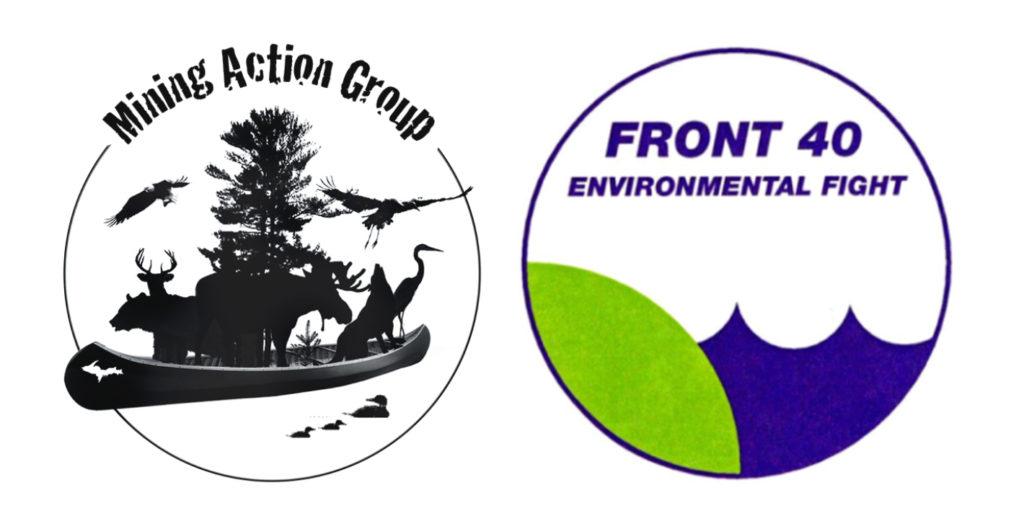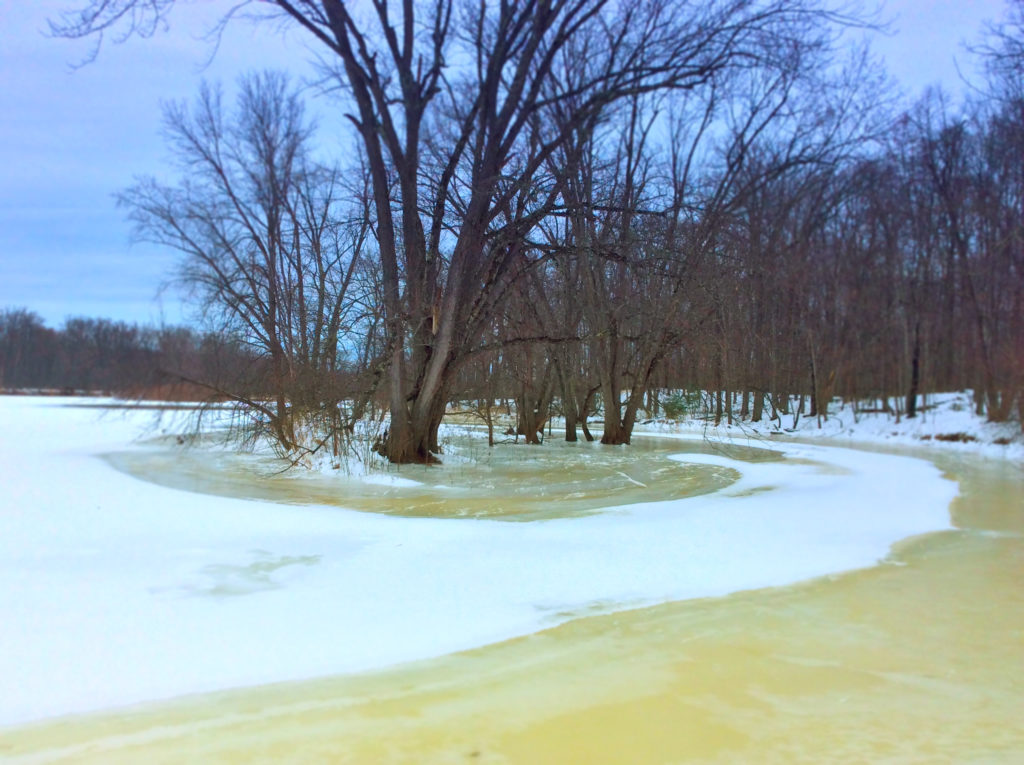
STEPHENSON, MI — The Front 40 Environmental Group and the Mining Action Group (MAG) of the Upper Peninsula Environmental Coalition (UPEC), working with regional environmental allies and fishing organizations, have secured an independent red flag review of Aquila Resources’ Back Forty Wetland permit application. The review was provided by the Center for Science in Public Participation (CSP2) which analyzes mining applications and provides objective research and technical advice to communities impacted by mining.
The Wetland application includes technical information regarding wetland hydrology, direct and indirect impacts to wetlands from the proposed sulfide mine and the on-site milling operation, a compensatory wetland and stream mitigation proposal, and more. CSP2’s technical review was completed by Dr. Kendra Zamzow (Ph.D., Environmental Geochemistry) and Dr. David Chambers (Ph.D., Geophysics).
CSP2’s report flags significant omissions in Aquila’s permit application, especially concerns related to the Feasible and Prudent (Least Environmentally Damaging Practicable) Alternatives analysis, the fundamental test of any wetland permit:
- “An environmental analysis needs to be conducted comparing the new proposed facility siting impacts on wetlands with the siting approved in the mining permit. The proposed single mine waste storage area is now two areas, and is much larger. The description of what is to be contained in each is inadequate and there is no description of the protections to be put in place.”
- “The former site plan was discarded in part because waste would be ‘less dense’ than anticipated. There is no explanation for what is behind the anticipated change in waste material density that drove the need for the greater area required for waste disposal…”
- “Given the terrain, direction of water flow, and proximity of valley wetlands and the River, this poses risks to wetlands – and aquatic resources in the River – that have not been analyzed.”
- “Although there is no formal proposal for underground mining, it is reasonable and foreseeable. Therefore the full potential life of the mine should be considered when evaluating feasible and prudent alternatives that are the least damaging to wetlands.”
- “An economic analysis needs to be conducted to determine the feasibility of moving the mill out of wetland areas.”
- “It appears that most of the stream and wetland impacts might be avoided if the mine facilities could be moved further upland to a dryland site, possibly on other state lands.”
Under Michigan regulations, Aquila bears the burden of demonstrating that either (a) the proposed activity is primarily dependent upon being located in the wetland, or (b) there are no feasible and prudent alternative, and they must show they are using all practical means to minimize impacts to wetlands.
According to CSP2’s review, “The mining permit and wetland permit are inextricably linked. The location and size of proposed mine site facilities as presented in the November 2017 Wetland Permit Application are different from those presented in the Mining Permit Application, and pose risks to wetlands that have not been analyzed.”
“This red flag review underscores our existing concerns. Aquila’s Wetland permit application is shoddy. It is mired in untested assumptions about wetland hydrology, and the whole scheme hinges on a facility design which nobody has reviewed, much less approved,” said Kathleen Heideman, a member of MAG.
Front 40 and the Mining Action Group will deliver CSP2’s review to the Michigan Department of Environmental Quality (DEQ) at the Public Hearing on January 23rd, and ask that key finding and recommendations be incorporated into the Wetland Permit review process.
“As soon as we saw the extent of the facility modifications, we asked the DEQ’s Office of Oil, Gas and Minerals to immediately require Aquila to apply for an amendment of the Back Forty Mine permit, or review the facility changes along with the Wetland permit – but they’ve refused to consider these questions until after the Wetland permit review is done,” said Heideman. [ See: “Significant Changes to Aquila Back Forty Mine” ]
“How many wetlands will be destroyed or impaired by the Back Forty? These wetlands are just in the way – Aquila will mine them out, or fill them in, or the surface water will be diverted, or they’ll be buried under mine waste tailings and waste rock storage areas. Are all of these wetland losses unavoidable? That’s the big question,” said Steve Garske, a member of MAG.
“Aquila Resources seeks to destroy wetlands in order to build a sulfide mine on the bank of the Menominee River. It is an alarming proposal, given the proximity of wetlands to the river, and concerns about the company’s plan to follow the orebody deeper underground. This site is complex, hydrologically, with wetlands on all sides, flowing in different directions. And the total wetland impacts may be significantly underestimated, since additional years of underground mining would greatly increase the groundwater drawdown,” said Heideman.
“Local residents are very frustrated, understandably. Aquila is using a bait-and-switch strategy. Since the facility’s impacts on wetlands are at the heart of the review, it would have made more sense to scrutinize all the proposed changes to the design first, before submitting the Wetland permit application. Aquila does everything backwards,” said Ron Henriksen, spokesman for the Front 40 group.
“Our goal is to identify errors and inconsistencies between data and Aquila’s predicted impacts to wetlands. We want to ensure that concerned citizens, stakeholders and environmental regulators are fully informed as to the true impacts of this permit,” said Nathan Frischkorn, a Fellow with the Mining Action Group.
A broad coalition of fishing groups, residents, tribal members and environmental groups are united in their opposition to the Aquila Back Forty project. Downstream communities are concerned about potential impacts to drinking water and tourism, and have passed resolutions against the project. Marinette County unanimously passed a resolution opposing the Back Forty; additional resolutions have been passed by the Menominee Indian Tribe of Wisconsin, the Oneida Nation, Keweenaw Bay Indian Community, Midwest Alliance of Sovereign Tribes, Amberg, Peshtigo, Porterfield, Sister Bay, Wagner, the City of Marinette, Door County, Oconto County, Outagamie County, Shawano County, Menominee County, and Brown County, which includes the city of Green Bay. After concerned citizens levied significant pressure on local officials, Menominee County became the first county in Michigan to pass a resolution opposed to the Back Forty mine.
“The Menominee River is my friend. It gives me and my fishing friends a lot of excitement when those bass, especially the big ones, are seen and when they strike at our flies. The Menominee is a valuable resource that shouldn’t be damaged or destroyed, which is why I’m working to protect it from the problems the proposed Back Forty mine would cause. I don’t want to lose the river to a polluting metallic sulfide mine,” said Dick Dragiewicz, an avid fisherman.
If fully permitted, the Back Forty will be a large open-pit sulfide mine on the bank of the Menominee River, the largest watershed in the wild Upper Peninsula of Michigan, only 100 feet from the water. Milling, using cyanide and other chemicals, and mine waste will be stored at the mine site, with some tailings waste remaining permanently. Most of the rock will be “reactive” or capable of producing acid mine drainage (AMD) when exposed to air and water. AMD devastates watersheds: it is difficult and expensive to remediate, and may continue leaching from the tailings for hundreds or thousands of years. American Rivers named the Menominee River to their list of “America’s Most Endangered Rivers” in 2017.

Suggested caption: “Sixty Islands section of the Menominee River, riparian wetlands located approximately 200 feet from the proposed Project Boundary of the Aquila Back Forty Mine site, January 9, 2018. Photo by Kathleen Heideman, Mining Action Group.”
Fundamental objections to the Aquila Back Forty project remain unresolved, and two contested case petitions have been filed over the Mining permit: one by an adjacent landowner, and another by the Menominee Indian Tribe of Wisconsin. The Back Forty Wetland application is now under review by the public, tribal stakeholders, environmental groups, Michigan DEQ, the Environmental Protection Agency, the U.S. Army Corps of Engineers, and the U.S. Fish and Wildlife Service.
“Wetlands are strictly protected under both state and federal law. Before wetlands can be destroyed, the company must demonstrate that wetland impacts are unavoidable. They’ve failed that test. I don’t see how this permit will pass muster with environmental regulators,” said Heideman.
“This mine threatens cultural and natural resources of the Menominee people, and the Shakey Lakes Savanna, a globally unique habitat. The Menominee River is the worst possible place for an open-pit sulfide mine. Aquila’s plan for on-site milling is especially dangerous, and needlessly destroys wetlands,” said Horst Schmidt, president of the Upper Peninsula Environmental Coalition.
Independent review of the Aquila Back Forty Wetland permit is made possible by the generous support of groups and individuals concerned about the future health of the Menominee River. Working collaboratively, the Mining Action Group of the Upper Peninsula Environmental Coalition and the Front 40 secured small grants and donations from Freshwater Future, Superior Watershed Partnership, the Western Mining Action Network, DuPage Rivers Fly Tyers (DRiFT), Northern Illinois Fly Tyers (NIFT), Badger Fly Fishers, M&M Great Lakes Sport Fisherman, Wisconsin Smallmouth Alliance, Fly Fishers International, Great Lakes Council of Fly Fishers International, the Emerick Family Fund, and individual fishing enthusiasts throughout the Great Lakes area.
PUBLIC PARTICIPATION
A Public Hearing for the Back Forty’s Wetlands, Lakes and Streams permit application will be held at 6 p.m. Central on January 23, 2018 at Stephenson High School, located at W526 Division Street, Stephenson, MI 49887. Note: due to public interest, the hearing has been moved to the school’s large gym. The deadline for submitting written comment is February 2, 2018.
- Download the Back Forty Wetland Permit application: http://bit.ly/DEQBack40Wetlandpermit
- Review the DEQ’s guidelines for the hearing:
http://bit.ly/Back40DEQ-statement - Attend the Public Hearing on January 23, 2018: http://www.michigan.gov/som/0,4669,7-192-47796-454935–,00.html
- Submit written comments:
http://bit.ly/Wetland-comments
####
Mission of the Upper Peninsula Environmental Coalition
Founded in 1976, the Upper Peninsula Environmental Coalition’s purpose remains unchanged: to protect and maintain the unique environmental qualities of the Upper Peninsula of Michigan by educating the public and acting as a watchdog to industry and government. UPEC is a nonprofit, registered 501(c)(3) organization. For more information, call 906-201-1949, see UPenvironment.org, or contact: upec@upenvironment.org.
Mission of the Mining Action Group
The UPEC Mining Action Group (MAG), formerly known as Save the Wild U.P., is a grassroots effort to defend the clean water and wild places of Michigan’s Upper Peninsula from the dangers of sulfide mining. Contact the Mining Action Group at info@savethewildup.org or call (906) 662-9987. Learn more about the Mining Action Group at miningactiongroup.org.
Mission of the Front 40 Environmental Group
The Front 40 is a grassroots organization that was formed in early 2003 in response to the threat of a metallic mineral mine potentially being developed on the shores of the Menominee River in Lake Township, Michigan. It is the principal objective of the Front 40 Environmental Group to ensure that metallic sulfide mining operations are not allowed to adversely impact our rivers, lakes, groundwater and lands. Learn more about the work of the Front 40 group: menomineeriver.com